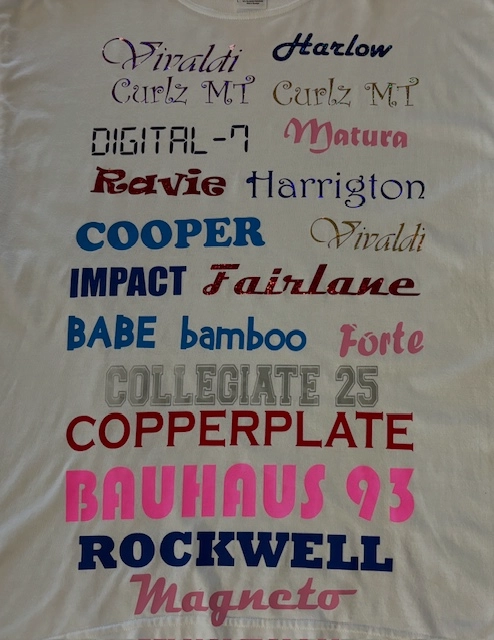The Art of Personalized Needlework: Opening the Keys to Creating One-of-a-kind and Memorable Styles
The secrets to producing custom-made embroidery designs that captivate the eye and leave a lasting impression lie in a fragile equilibrium of method, creativity, and focus to detail. As we dive into the world of custom needlework, we reveal the nuanced interaction in between thread option, sew complexity, and layout personalization that elevates a simple garment to a work of art.
Choosing the Right Embroidery Threads
When choosing needlework strings, what essential variables should you consider to make sure the very best results for your custom-made designs? The choice of embroidery string is essential in establishing the last end result of your embroidered design. One of the main factors to consider is the material of the thread. Different products such as cotton, polyester, rayon, and silk offer varying levels of shine, toughness, and appearance. It is vital to choose a string product that matches the material you are stitching on and aligns with the wanted look of the design.
Thicker threads can add dimension and appearance to your style, while finer threads are suitable for complex details and small text. In addition, taking into consideration the color fastness and washability of the string is critical to guarantee that your customized styles keep their quality and vibrancy over time.
Checking Out Various Stitch Methods
To explore the realm of 'Discovering Various Stitch Strategies', one must grasp the complexities and nuances that each stitching technique gives the art of needlework. Various stitch techniques not just add visual rate of interest yet likewise add to the total structure and measurement of the layout. One preferred stitch strategy is the satin stitch, which entails closely stuffed parallel stitches to develop a smooth and glossy surface area, ideal for filling up in forms and creating strong describes.
On the other hand, the backstitch is a functional strategy frequently used for laying out and including fine information. It involves sewing in reverse to develop a strong line of embroidery. Additionally, the French knot stitch includes a responsive component to layouts, perfect for creating textured accents like blossom facilities or decorative touches.
Checking out various stitch strategies enables embroiderers to have fun with light, shadow, and depth within their styles, boosting the visual appeal and artistic high quality of their needlework tasks. By grasping different sewing approaches, one can open endless opportunities for developing unique and memorable custom-made embroidery items.
Incorporating Personalized Style Aspects
Having actually discovered the ins and outs of different stitch methods such as the satin stitch, backstitch, and French knot, the emphasis now shifts towards integrating individualized design elements in custom-made embroidery projects. Personalized style elements play an important function in making needlework jobs truly special and memorable. One way to integrate personalization is by adding initials, names, or significant days to the design. This not only adds a personalized touch but likewise improves the nostalgic value of the embroidery item.
An additional means to incorporate tailored design aspects is by including signs or concepts that hold special definition to the recipient or mirror their passions and personality. For instance, incorporating a favorite flower, animal, or hobby-related symbol can make the needlework style more meaningful and tailored. Additionally, choosing shades that resonate with the recipient or align with the designated style can further improve the customization of the needlework job.
Mastering the Art of Color Sychronisation
One secret facet of color sychronisation is recognizing color theory. This consists of knowing exactly how various shades communicate with each various other, the feelings they convey, and exactly how they can be incorporated to develop visually attractive styles. By using color theory principles, embroiderers can produce unified shade palettes that enhance the general appearance of the layout.
Additionally, paying interest to comparison is critical in color coordination. Using contrasting shades can aid particular elements of the design pop, enhance readability, and develop an aesthetically dynamic embroidery piece. By grasping the art of shade control, embroiderers can boost their layouts and develop memorable pieces that resonate with clients and audiences alike.
Enhancing Structure With Advanced Embroidery Stitches

Bullion knots, on the other hand, can be used to produce twisted, ropelike components that include an elegant feel to the needlework. Exploring with these sophisticated embroidery stitches allows you to press the limits of conventional embroidery and develop genuinely distinct and visually enticing structures in your designs.
Verdict
To conclude, the art of customized embroidery includes a combination of picking the ideal threads, discovering different stitch strategies, integrating individualized design components, mastering shade sychronisation, and boosting structure with advanced stitches. By comprehending and implementing these vital aspects, embroiderers can develop distinct and remarkable styles that display their imagination and ability. Embroidery lovers can open the keys to producing beautiful and custom items that stand apart and leave a long-term More hints impression.